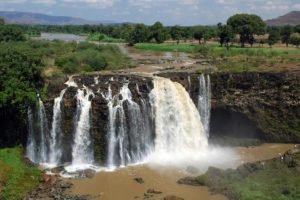
The Blue Nile, upstream from the soon to be opened Grand Ethiopian Renaissance Dam
By Chris Fitch
Egypt is dependent on the River Nile – 95 per cent of the 97 million population lives within 20km of the river, the country’s only perennial water supply, with the rest of the arid desert landscape either sparsely populated or entirely uninhabited. Hence, the mounting fears in Cairo over the consequences of the dam that Ethiopia is building across the Blue Nile, around 20km upstream of the Sudanese border which will create a 1,680 sq km reservoir holding 74 billion cubic metres of water, equivalent to the entire annual flow of the river.
Expected to be finished in the next few months, the Grand Ethiopian Renaissance Dam (GERD) aims to utilise the power of the Blue Nile – which provides as much as 57 per cent of the Nile’s flow once the White and Blue Niles meet in Khartoum – to power a country severely lacking in reliable and sustainable power supplies.
Despite years of negotiations and an imminent finishing line, there remains significant uncertainty about which strategy will be adopted for the all-important process of filling the vast reservoir which will displace 20,000 people.
‘There’s a lot of concern regarding when and how they’ll begin to fill the reservoir relative to the construction schedule of the dam. It’s one of the major issues in the negotiations,’ explains Kevin Wheeler, from the Environmental Change Institute at the University of Oxford.
Such a project has the potential to have a significant impact downstream, with rumours circulating that Egypt could suffer as much as a 50 per cent drop in viable agricultural land.
While Wheeler doubts that the dam would be filled in the fastest possible time frame of only three years – the nightmare scenario for Egypt in which only a minimal amount of water would be able to flow downstream – the actual strategy remains yet to be announced.
‘We want to try to avoid being alarmist, while highlighting the real risks and identifying practical solutions’ says Wheeler. ‘There’s a lot of rhetoric that floats around in the press, and we’ve been working really hard to try to educate the media about what the actual risks are. Some media outlets are fanning the flames with exaggerations, and making rational dialogue much more difficult.’
The GERD was first mooted in 1964, yet construction didn’t finally commence until 2011, with a budget of $4.8billion. It is a figure that underlines the economic and symbolic importance of this project. ‘Most Ethiopians pay about a month of their salary to build the dam,’ reveals Wheeler. ‘It gives you an idea of how much of a national identity this has become. It demonstrates a phenomenal degree of national drive. It will be a very, very big deal once it’s finished.’
Source: Geographical


